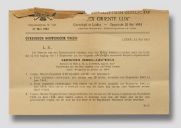Escape from reality
NINO had, and still has, close ties with Ex Oriente Lux (EOL), a society that aims to disseminate knowledge of the Ancient Near East to a broad public. During the Second World War, EOL’s membership exploded. Members could apply for courses in Akkadian, Egyptian and Arabic. Practice material was sent in the mail, and could be done at home. Assignments were sent back to the teacher, corrected, and returned with corrections, together with the material for the next lesson. Local departments of Ex Oriente Lux organized meetings throughout the country that employees of NINO attended to give lectures. To the German occupier, these lectures seemed to be less innocent than you would expect based on their content.
Here you see an old projector. Tools like these were used a lot for so-called ‘lectures with light images’. Even during the war. Or, rather: especially during the war. You might think that people had other things on their mind during that time than a presentation on ancient Egyptian art or inscriptions in cuneiform. But the opposite is true. There turned out to be a great thirst for knowledge about cultures and civilizations of long, long ago. It almost seems like the dark years of war inspired an escape into history.
Sebastiaan: Yes, that was an interesting discovery, that the war also meant – kind of like the Netherlands currently during the pandemic
This is Sebastiaan Berntsen again, archivist at the NINO.
Sebastiaan: And the NINO and Ex Oriente Lux filled that space by providing courses, written courses, and it could be in all kinds of fields: art history, but ancient languages too. If you wanted to, you could just start learning hieroglyphs by mail. That was a popular one…
The NINO’s archive has many surviving documents that attest to the great enthusiasm for the ancient Near East during the war. The society, Ex Oriente Lux, catered to that need. The society was closely connected to NINO. And disseminated the academic insights to a broader audience.
Sebastiaan: Yes, and it was a big group of people. By Dutch standards , really big, with departments in Belgium and France even. And the history of the ancient Near East was actually kind of ‘hip’ in the Netherlands, before the war. It was, generally, a bit of a ‘chic’ audience. A lot of students, obviously, and former students. But also, yes, people who had money to travel, who bought books, read books, that’s definitely something you notice in the membership lists of Ex Oriente Lux, these are people who did have some money to spend.
And yes, especially in the Netherlands, there was an interest in that history, from the religious side as well. These are the countries of the Bible, after all: the Persians, the Egyptians, the ancient Israelites. Those are all peoples from the Bible. In the Netherlands, with its protestant, Calvinist tradition, there had of course always been an interest in those things.
Ex Oriente Lux continued to organize lectures throughout the country during the war. In a letter written right after the war ended, NINO curator Arie Kampman writes that his colleagues weren’t always happy about that.
The orientalists did protest, if they had to go and give lectures, but they did it anyway, for the good cause, in all kinds of weather, snow and ice, crammed into animal wagons, at drafty train stations and on rattling buses.
‘For the good cause’: Kampman clearly considered it his moral duty to spread as much knowledge about the ancient Near East as possible. And in the eyes of the German occupier, sharing this knowledge wasn’t as innocent as we would think. In the archive, we found, for example, a request of the Head of the Department of Active Propaganda. This man, called Henk Plaizier, demanded to see the content of a lecture a member of Ex Oriente Lux would give in Maastricht beforehand.
Perhaps Hank Plaizier, NSB member from day one, had been tipped off by one Mackenzie, a national-socialist that, according to a letter from the archive, voices his protest against the anti-German atmosphere at the The Hague department of Ex Oriente Lux.






